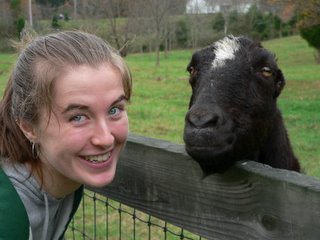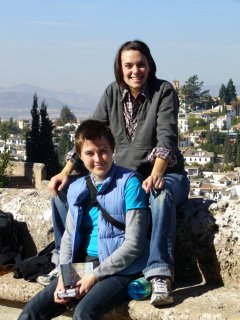
Hello friends!
I hate to send a group message, but contact with the outside world turns out to be quite precious. Somehow I never imagined that we would be somewhere this remote. Fortunately, everything has gone more smoothly than we possibly could have hoped for... but it has still resulted in us being in the middle of nowhere for the past 10 days. I just used a flush toilet for the first time in quite a while!!
Basically, I got into Malaga, a town in Andalucia, southern Spain, at 10:00 at night last Wednesday. I got a taxi to the hostel where Nicci was waiting for me on the front porch. We had a joyful reunion, went inside and woke up Catherine and sat around talking about how stinky we were. Just like old times!! The next day we got a bus to Ronda, a little town up in the mountains. The scenery is unbelievable. First we drove down the Costa del Sol, the Mediterranean coast, with sparking blue waters and seaside resorts. Then we curved up into chalky limestone mountains scattered with goats and tufty heather and pinsapo trees... it was incredibly remote, like northern Scotland but polka-dotted only occasionally with tiny hamlets of whitewashed buildings with red roofs, like Italian hill towns.
In Ronda we were supposed to have to ride an ass-buster bus to a tiny village of 800 people called Jubrique, but fortunately our farmers picked us up in their land rover and drove us to the farm about an hour away. Our farmers - ha! They’re great. We were so scared they were going to be creepy weirdos but they’re not. James is a young guy from East London who has lived here for 3 years, Rory is an Irishman from Dublin who has lived here for 23 years and is raising his 6 year old son Felix after being abandoned by his exwife who left him for a crazy Spaniard. James is very chatty and likes to swig the ol' Cruzcampo, but has taught us to identify wild mushrooms, herbs, and fruits, not to mention how to brandish long-handled scythes and whitewash a building. Rory is very quiet and softspoken but very, very kind and interested in hearing about our lives. Felix is a crazy little kid with a very interesting upbringing. He went around for 2 days with soot smeared all over his face before Rory finally made him wash it off using rainwater collecting in a rusty wheelbarrow. He's going to be the hearty type. As are we.
The farm!!! I wish you could see it. It is like Heidi times a Mexican rancho meets Laura Ingalls Wilder. An 1800s farmhouse set in the hillside, white stucco and terra cotta... the hillsides are so steep they have to be terraced so you can climb up and down. You drive about 45 minutes on a dirt track to get there. One solar panel which works occasioanlly... other than that we cook over the fireplace, drink and wash with water pumped out of a spring on the hillside. Our kitchen looks like a kitchen in one of those educational houses you go to in 3rd grade to learn "this is how the pioneers lived!" A rough hewn table, hand jarred olives on the table. The farm was abandoned for 15 years, and then Rory was putting it back together but now he has to live in Jubrique so Felix can go to school, so it is falling apart again. So basically we are being paid to live there and keep it from falling apart.
As it turns out, Rory and James are working on a building project at the coast right now so we are on our own. James stayed with us for the first few days to teach us how to survive, and now Rory comes down to check on us and bring us provisions every few days, but other than that we are on our own. Our day goes something like this: wake up. crawl out of sleeping bag. Build fire, put on water for tea and breakfast. Wash up while water is heating. Eat breakfast while heating more water for dishes. Wash dishes. Go to work: slash briars off the hillside, unearth broken fences, fix abandoned vegetable beds. Restoke the fire, reheat leftovers for lunch, drink tea and rest. Back to work: whitewash the house, haul dead logs off the hillside, chop firewood, harvest wild fruit. There are apples, figs, kiwis, grapes, chestnuts, olives, carrots, persimmons, and all kinds of herbs growing untamed. The persimmons are as big as half my fist!! The sink, which is outside, is overgrown with a mad tangle of kiwi vines.
Anyway, at 6-ish we stop working, restoke the fire again, put supper on to cook. As it gets dark we sit outside and watch the sun setting against the opposite hillside and listen to the constant jangling of goat bells. They belong to Jose, our nearest neighbor, who grows hashish and comes by occasionally selling pails of goat milk, which is fine to buy but you have to boil it first so you don’t get Maltese fever. So then we eat, and then is the nicest part of the day, sitting around the fire drinking wine and laughing like maniacs. It feels so good to be with Catherine and Nicci!! It feels like we were never apart.
So this is what we have done every day pretty much, except last Sunday, our ‘day off’in which we climbed up a huge mountain and got lost in the pinsapo forest, but we could see out across the Mediterranean all the way to Gibraltar and we could even see the distant shadow of Africa across the water. And on the weekends it’s slightly different because the guys all come down.
We’re all dirty as sin. I have 65 scratches on my right hand alone from the stupid brambles, and most of them are deeply encrusted with black dirt, as is my face. This morning Rory came to drop off a load of fresh veggies from James’ parents garden, and he proposed that we come down to Estepona, a town on the coast where he and James are building, for the day. We got ready in 2 seconds flat, throwing on our "fancy clothes" but I forgot to wash my hands and I think they may offend people. I think I probably smell offensive as well... Also, we cut my hair again a while ago. But we did it by firelight, so the result is that I now look like a rat with a buzz. Awesome. At least there is no one to see it except the goats.
So that is a hysterical recounting of events. It sounds idyllic and amazing but it has been really difficult. Physically, yes, but also emotionally, because it’s such a different lifestyle and I really want to like it but I can’t force myself to if I don’t. At first it was so novel it was easy to like. Then we hit a slump where we were exhausted and filthy and confused and we hated it. Then we pulled out of the slump and now we are feeling really good. All the things that are difficult at home just aren’t here. I don’t eat crappy junk food because there isn’t any to be had. I don’t sit around slothfully indoors at a computer because there isn’t one. I’m active and outdoors all day long and it feels good. We come in feeling tired and well used, but not as torn down as on the Appalachian Trail. Of course there are also bad moments that are vexing and trying but not nearly as much as I thought they would be. Actually, the only really difficult thing is being SO isolated... it would be a day’s walk to the nearest town, and our phone doesn’t work at all, really. If we need something, we are out of luck.
Adios to all
Sara Kate













